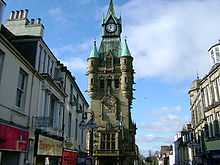Dunfermline City Chambers

Dunfermline City Chambers is a building historically designed to be the centre of local government in Dunfermline, Fife. In more recent times most of these functions have been devolved to other locations, but [as of 2008] the impressive edifice still houses the Council Chambers, the Burgh Court and Dunfermline's Registrar Office.
The building, constructed in the period 1875-79, was created by James C Walker who also designed the first Carnegie Library. It employs a harmonious composite of French, Gothic and Scots baronial architectural styles and features a prominent four-face clock tower. It was constructed on the site of an older Town House of 1771 which was in its turn built to replace the 17th century Town House, demolished as part of 18th century improvements to make way for Bridge Street.
There are many features of historic and architectural significance in the building. The structure includes heraldic stones recovered from the demolished 1771 Town House. These are plausibly believed to have originated from the now derelict Royal Palace of Dunfermline a few hundred yards to the south. The finely designed interior of the City Chambers incorporates many notable features, in particular the oak hammer beam roof which provides the ceiling for the Council Chamber itself. The historic police cells, although no longer in use, have also been preserved.
Furnishings include a number of notable artworks including busts of several Scottish sovereigns, a statue of Robert Burns, Sir Joseph Noel Paton's painting, Spirit of Religion, and an early twentieth century portrait of King Malcolm and Queen Margaret.
References
- Fife Direct website
- Visit Dunfermline (Note: scroll down through the list)
- Bert McEwan, Dunfermline: Our Heritage, 1998
See also
Coordinates: 56°04′15″N 3°27′50″W / 56.0708°N 3.4640°W